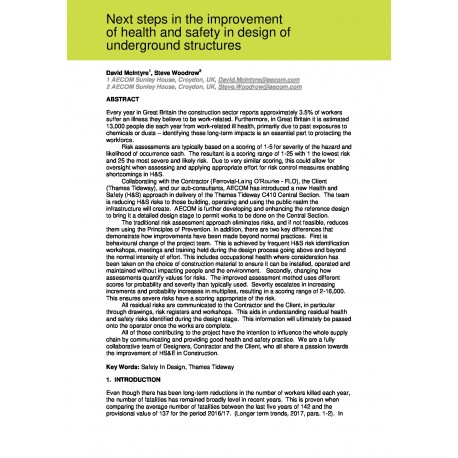Cart
0
0
No document
0,00 €
Total
Document successfully added to your shopping cart
Quantity
Total
There are 0 items in your cart.
There is 1 item in your cart.
Total documents
Total shipping
To be determined
Total
Search & filter
Search for a publication
Search & filter
Next steps in the improvement of health and safety in design of underground structures
2657_next_steps_in_the_improveme
Every year in Great Britain the construction sector reports approximately 3.5% of workers suffer an illness they believe to be work-related. Furthermore, in Great Britain it is estimated 13,000 people die each year from work-related ill health, primarily due to past exposures to chemicals or dusts – identifying these long-term impacts is an essential part to protecting the workforce. Risk assessments are typically based on a scoring of 1-5 for severity of the hazard and likelihood of occurrence each. The resultant is a scoring range of 1-25 with 1 the lowest risk and 25 the most severe and likely risk. Due to very similar scoring, this could allow for oversight when assessing and applying appropriate effort for risk control measures enabling shortcomings in H&S. Collaborating with the Contractor (FerrovialLaing O’Rourke - FLO), the Client (Thames Tideway), and our sub-consultants, AECOM has introduced a new Health and Safety (H&S) approach in delivery of the Thames Tideway C410 Central Section. The team is reducing H&S risks to those building, operating and using the public realm the infrastructure will create. AECOM is further developing and enhancing the reference design to bring it a detailed design stage to permit works to be done on the Central Section. The traditional risk assessment approach eliminates risks, and if not feasible, reduces them using the Principles of Prevention. In addition, there are two key differences that demonstrate how improvements have been made beyond normal practices. First is behavioural change of the project team. This is achieved by frequent H&S risk identification workshops, meetings and training held during the design process going above and beyond the normal intensity of effort. This includes occupational health where consideration has been taken on the choice of construction material to ensure it can be installed, operated and maintained without impacting people and the environment. Secondly, changing how assessments quantify values for risks. The improved assessment method uses different scores for probability and severity than typically used. Severity escalates in increasing increments and probability increases in multiplies, resulting in a scoring range of 2-16,000. This ensures severe risks have a scoring appropriate of the risk. All residual risks are communicated to the Contractor and the Client, in particular through drawings, risk registers and workshops. This aids in understanding residual health and safety risks identified during the design stage. This information will ultimately be passed onto the operator once the works are complete. All of those contributing to the project have the intention to influence the whole supply chain by communicating and providing good health and safety practice. We are a fully collaborative team of Designers, Contractor and the Client, who all share a passion towards the improvement of HS&E in Construction.




